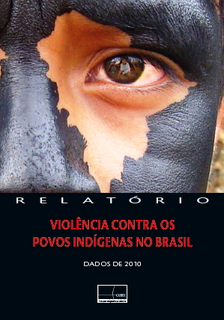Violence against indigenous peoples in Brazil: Everything remains the same!
 Thursday, June 30, the Indigenist Missionary Council (Cimi) releases the Year Report Violence Against Indigenous Peoples in Brazil – 2010.
Thursday, June 30, the Indigenist Missionary Council (Cimi) releases the Year Report Violence Against Indigenous Peoples in Brazil – 2010.
Release will be at the headquarters of the National Conference of Bishops of Brazil (CNBB), in Brasília, at 15.00hrs.
Lead researcher Lucy Helena Rangel will present the year report, together with the president of CIMI, Dom Erwin Kräutler, vice-president Roberto Antonio Liebgott, as well as Egydio Schwade, who wrote the chapter on the near extermination of the Waimiri-Atroari people during the dictatorship, in the sixties and seventies of the last century.
These are some of the data presented by the Indigenous Missionary Council (CIMI) in the report on Violence Against Indigenous Peoples in Brazil -2010:
· Only in 2010, 92 children died for lack of medical care or adequate health care for the mother at childbirth;
· 60 Indigenous were killed, another 152 received death threats;
· At least 42 thousand suffered of lack of health care and education, among others;
· 33 cases of invasions and illegal exploitation of natural resources on indigenous lands were recorded
These data prove that year after year the occurrence of violence and violations of Indigenous Rights in Brazil remains the same: "Yes, everything is the same! Some occurrences increase, others decrease or remain the same, but the scenario is the same and the factors of violence remain, reproducing the same problems," said Lucia Helena Rangel, coordinator of the research, professor of Anthropology at the PUC University in of São Paulo.
Violence in Mato Grosso do Sul
Again, for the third consecutive year, 60 murders were recorded. Most, 34, occurred in the state of Mato Grosso do Sul, or 56% of the total. In this state, home to the second largest indigenous population of the country, with more than 53 000 people, their Constitutional Rights are more than ignored.
Last year, at the launch of the 2009 report Iara Tatiana Bonin, characterized the situation in Mato Grosso do Sul as “institutional racism”. Lucia Helena Rangel calls it genocide, because besides the highest number of murders, the state also has the highest percentage of attempted murder and other rights violations, such as various threats and malicious injury, lack of land demarcation, lack of health care, lack of education.
Violence and the land issue
The 92 cases of violence against indigenous property, as well as many other cases, make it clear that the conflictive situation experienced by indigenous Brazilians is closely linked to the development model adopted by the government and lack of access to land. "Once again we can confirm that the backdrop of violence committed against indigenous peoples, as well as the violations of their Rights, is the disrespect for the demarcation of their lands. Delay in the regularization of their lands, overcrowded areas, extremely confined populations, among others, are the main sources of conflict, death and despair," said Lucia Rangel.
Alarming infant mortality
The infant mortality rates are also alarming. Only in 2010, 92 children under five died from easily treatable diseases. An increase of 513% compared to 2009, when 15 cases were recorded, with 15 victims. Among these cases, an unfortunate emphasis on the dismal situation of the Xavante people of the state of Mato Grosso, who lost 60 of 100 children born alive: all victims of malnutrition, respiratory diseases and infectious diseases.
Outcasts
For all these reasons, the conclusion is that the violence against indigenous people in the country remains the same. “The indigenous continue nailed to the cross, violated and murdered, expelled or defrauded of their ancestral lands, reduced to outcasts of the society, shunned like animals, treated as tramps by the roadside, or otherwise, confined in truly human pens, without the minimal conditions for their physical, let alone their cultural survival!” said Bishop Kräutler, president of Cimi.
Methodology and purpose
The research methodology employed is the same as in previous years: cases were selected from a variety of print, radio and virtual media, as well as from the systematic records made by Cimi teams spread across the eleven regions of the country. In addition, information comes from police reports and the Federal Public Ministry. These records do not exhaust the occurrences that actually happened, but they indicate the trends and characteristics of attacks and threats to this population.
Cimi publishes this report to avoid that the reality of violence against these people becomes trivial, presenting it to Human Rights organizations – national and international -, legislators, judges and state officials.
Inalienable and sacred
As stated by Dom Erwin Kräutler, with this report, the Indigenous Missionary Council once again affirms their commitment to the indigenous peoples in Brazil, in defence of their dignity and their inalienable and sacred Rights.
Practical information:
Release of the Relatório de Violência contra Povos Indígenas no Brasil – 2010
When: June 30, at 15.00 hrs
Where: head quarters of the CNBB, Setor de Embaixadas Sul Qd. 801, Conjunto B, Brasília/DF, Brazil
Informações: Cleymenne Cerqueira (+55) 61 2106.1667 or (+55) 61 9979-7059
International Press: Paul Wolters (+55) 61 2106-1666 or (+55) 61 9953-8959

